[English] 日本語
 Yorodumi
Yorodumi- PDB-4xss: Insulin-like growth factor I in complex with site 1 of a hybrid i... -
+ Open data
Open data
- Basic information
Basic information
| Entry | Database: PDB / ID: 4xss | |||||||||
|---|---|---|---|---|---|---|---|---|---|---|
| Title | Insulin-like growth factor I in complex with site 1 of a hybrid insulin receptor / Type 1 insulin-like growth factor receptor | |||||||||
 Components Components |
| |||||||||
 Keywords Keywords | Hormone/hormone receptor / CELL SURFACE RECEPTOR/IMMUNE SYSTEM / INSULIN RECEPTOR / CT PEPTIDE / INSULIN-LIKE GROWTH FACTOR RECEPTOR / HORMONE RECEPTOR-HORMONE-IMMUNE SYSTEM COMPLEX / Hormone-hormone receptor complex | |||||||||
| Function / homology |  Function and homology information Function and homology informationglycolate metabolic process / muscle hypertrophy / negative regulation of oocyte development / insulin-like growth factor binding protein complex / insulin-like growth factor ternary complex / positive regulation of trophectodermal cell proliferation / prostate gland stromal morphogenesis / positive regulation of type B pancreatic cell proliferation / positive regulation of glycoprotein biosynthetic process / type II pneumocyte differentiation ...glycolate metabolic process / muscle hypertrophy / negative regulation of oocyte development / insulin-like growth factor binding protein complex / insulin-like growth factor ternary complex / positive regulation of trophectodermal cell proliferation / prostate gland stromal morphogenesis / positive regulation of type B pancreatic cell proliferation / positive regulation of glycoprotein biosynthetic process / type II pneumocyte differentiation / neuronal dense core vesicle lumen / proteoglycan biosynthetic process / regulation of establishment or maintenance of cell polarity / protein kinase complex / chondroitin sulfate proteoglycan biosynthetic process / insulin-like growth factor receptor activity / myotube cell development / positive regulation of transcription regulatory region DNA binding / negative regulation of neuroinflammatory response / insulin-like growth factor binding / Signaling by Type 1 Insulin-like Growth Factor 1 Receptor (IGF1R) / skeletal muscle satellite cell maintenance involved in skeletal muscle regeneration / protein transporter activity / bone mineralization involved in bone maturation / positive regulation of cell growth involved in cardiac muscle cell development / IRS-related events triggered by IGF1R / negative regulation of vascular associated smooth muscle cell apoptotic process / positive regulation of cerebellar granule cell precursor proliferation / lung vasculature development / exocytic vesicle / transcytosis / cerebellar granule cell precursor proliferation / regulation of female gonad development / positive regulation of myoblast proliferation / positive regulation of meiotic cell cycle / lung lobe morphogenesis / positive regulation of myelination / negative regulation of androgen receptor signaling pathway / cell activation / insulin-like growth factor II binding / glial cell differentiation / positive regulation of developmental growth / positive regulation of calcineurin-NFAT signaling cascade / prostate gland growth / male sex determination / transmembrane receptor protein tyrosine kinase activator activity / insulin receptor complex / insulin-like growth factor I binding / positive regulation of protein-containing complex disassembly / type B pancreatic cell proliferation / insulin receptor activity / mammary gland development / exocrine pancreas development / alphav-beta3 integrin-IGF-1-IGF1R complex / myoblast differentiation / cell surface receptor signaling pathway via STAT / regulation of nitric oxide biosynthetic process / positive regulation of insulin-like growth factor receptor signaling pathway / positive regulation of Ras protein signal transduction / dendritic spine maintenance / regulation of JNK cascade / cargo receptor activity / peptidyl-tyrosine autophosphorylation / positive regulation of smooth muscle cell migration / growth hormone receptor signaling pathway / insulin binding / positive regulation of DNA binding / adrenal gland development / negative regulation of interleukin-1 beta production / PTB domain binding / lung alveolus development / neuronal cell body membrane / muscle organ development / Signaling by Insulin receptor / IRS activation / cellular response to insulin-like growth factor stimulus / branching morphogenesis of an epithelial tube / positive regulation of cardiac muscle hypertrophy / androgen receptor signaling pathway / prostate epithelial cord arborization involved in prostate glandular acinus morphogenesis / negative regulation of release of cytochrome c from mitochondria / type I pneumocyte differentiation / positive regulation of respiratory burst / negative regulation of smooth muscle cell apoptotic process / inner ear development / negative regulation of amyloid-beta formation / amyloid-beta clearance / myoblast proliferation / Respiratory syncytial virus (RSV) attachment and entry / positive regulation of activated T cell proliferation / insulin receptor substrate binding / regulation of embryonic development / positive regulation of receptor internalization / negative regulation of tumor necrosis factor production / epithelial to mesenchymal transition / Synthesis, secretion, and deacylation of Ghrelin / blood vessel remodeling / activation of protein kinase B activity / epidermis development / protein kinase activator activity Similarity search - Function | |||||||||
| Biological species |  Homo sapiens (human) Homo sapiens (human) | |||||||||
| Method |  X-RAY DIFFRACTION / X-RAY DIFFRACTION /  SYNCHROTRON / SYNCHROTRON /  MOLECULAR REPLACEMENT / Resolution: 3 Å MOLECULAR REPLACEMENT / Resolution: 3 Å | |||||||||
 Authors Authors | Lawrence, C. / Kong, G.K.-W. / Menting, J.G. / Lawrence, M.C. | |||||||||
| Funding support |  Australia, 2items Australia, 2items
| |||||||||
 Citation Citation |  Journal: Structure / Year: 2015 Journal: Structure / Year: 2015Title: Structural Congruency of Ligand Binding to the Insulin and Insulin/Type 1 Insulin-like Growth Factor Hybrid Receptors. Authors: Menting, J.G. / Lawrence, C.F. / Kong, G.K. / Margetts, M.B. / Ward, C.W. / Lawrence, M.C. #1:  Journal: PROC.NATL.ACAD.SCI.USA / Year: 2014 Journal: PROC.NATL.ACAD.SCI.USA / Year: 2014Title: PROTECTIVE HINGE IN INSULIN OPENS TO ENABLE ITS RECEPTOR ENGAGEMENT Authors: Menting, J.G. #2:  Journal: Nature / Year: 2013 Journal: Nature / Year: 2013Title: How insulin engages its primary binding site on the insulin receptor Authors: Menting, J.G. | |||||||||
| History |
|
- Structure visualization
Structure visualization
| Structure viewer | Molecule:  Molmil Molmil Jmol/JSmol Jmol/JSmol |
|---|
- Downloads & links
Downloads & links
- Download
Download
| PDBx/mmCIF format |  4xss.cif.gz 4xss.cif.gz | 175.7 KB | Display |  PDBx/mmCIF format PDBx/mmCIF format |
|---|---|---|---|---|
| PDB format |  pdb4xss.ent.gz pdb4xss.ent.gz | 141 KB | Display |  PDB format PDB format |
| PDBx/mmJSON format |  4xss.json.gz 4xss.json.gz | Tree view |  PDBx/mmJSON format PDBx/mmJSON format | |
| Others |  Other downloads Other downloads |
-Validation report
| Summary document |  4xss_validation.pdf.gz 4xss_validation.pdf.gz | 1.1 MB | Display |  wwPDB validaton report wwPDB validaton report |
|---|---|---|---|---|
| Full document |  4xss_full_validation.pdf.gz 4xss_full_validation.pdf.gz | 1.1 MB | Display | |
| Data in XML |  4xss_validation.xml.gz 4xss_validation.xml.gz | 15.7 KB | Display | |
| Data in CIF |  4xss_validation.cif.gz 4xss_validation.cif.gz | 20.5 KB | Display | |
| Arichive directory |  https://data.pdbj.org/pub/pdb/validation_reports/xs/4xss https://data.pdbj.org/pub/pdb/validation_reports/xs/4xss ftp://data.pdbj.org/pub/pdb/validation_reports/xs/4xss ftp://data.pdbj.org/pub/pdb/validation_reports/xs/4xss | HTTPS FTP |
-Related structure data
| Related structure data |  4xstC  3loh C: citing same article ( S: Starting model for refinement |
|---|---|
| Similar structure data |
- Links
Links
- Assembly
Assembly
| Deposited unit | 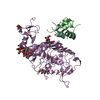
| ||||||||
|---|---|---|---|---|---|---|---|---|---|
| 1 |
| ||||||||
| 2 | x 6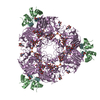
| ||||||||
| Unit cell |
|
- Components
Components
-Insulin-like growth factor ... , 2 types, 2 molecules BF
| #1: Protein | Mass: 7663.752 Da / Num. of mol.: 1 / Fragment: UNP residues 49-118 Source method: isolated from a genetically manipulated source Source: (gene. exp.)  Homo sapiens (human) / Gene: IGF1, IBP1 / Production host: Homo sapiens (human) / Gene: IGF1, IBP1 / Production host:  |
|---|---|
| #3: Protein/peptide | Mass: 1947.195 Da / Num. of mol.: 1 / Fragment: Alpha-CT peptide, UNP residues 691-706 / Source method: obtained synthetically / Details: Chemical synthesis / Source: (synth.)  Homo sapiens (human) / References: UniProt: P08069*PLUS Homo sapiens (human) / References: UniProt: P08069*PLUS |
-Protein / Non-polymers , 2 types, 2 molecules E

| #2: Protein | Mass: 36231.762 Da / Num. of mol.: 1 / Fragment: L1-CR, UNP residues 28-377 Source method: isolated from a genetically manipulated source Source: (gene. exp.)  Homo sapiens (human) / Gene: INSR / Cell line (production host): LEC 8 MUTANT CHO CELL / Production host: Homo sapiens (human) / Gene: INSR / Cell line (production host): LEC 8 MUTANT CHO CELL / Production host:  References: UniProt: P06213, receptor protein-tyrosine kinase |
|---|---|
| #6: Chemical | ChemComp-SO4 / |
-Sugars , 3 types, 6 molecules 
| #4: Polysaccharide | beta-D-mannopyranose-(1-4)-2-acetamido-2-deoxy-beta-D-glucopyranose-(1-4)-[alpha-L-fucopyranose-(1- ...beta-D-mannopyranose-(1-4)-2-acetamido-2-deoxy-beta-D-glucopyranose-(1-4)-[alpha-L-fucopyranose-(1-6)]2-acetamido-2-deoxy-beta-D-glucopyranose |
|---|---|
| #5: Polysaccharide | 2-acetamido-2-deoxy-beta-D-glucopyranose-(1-4)-[alpha-L-fucopyranose-(1-6)]2-acetamido-2-deoxy-beta- ...2-acetamido-2-deoxy-beta-D-glucopyranose-(1-4)-[alpha-L-fucopyranose-(1-6)]2-acetamido-2-deoxy-beta-D-glucopyranose |
| #7: Sugar | ChemComp-NAG / |
-Details
| Has protein modification | Y |
|---|
-Experimental details
-Experiment
| Experiment | Method:  X-RAY DIFFRACTION / Number of used crystals: 1 X-RAY DIFFRACTION / Number of used crystals: 1 |
|---|
- Sample preparation
Sample preparation
| Crystal | Density Matthews: 6.11 Å3/Da / Density % sol: 79.87 % |
|---|---|
| Crystal grow | Temperature: 298 K / Method: vapor diffusion, hanging drop / pH: 10.5 Details: 1.75 M ammonium sulfate, 0.1 M CAPS-NaOH (pH 10.5), 0.2 M LiSO4 |
-Data collection
| Diffraction | Mean temperature: 100 K |
|---|---|
| Diffraction source | Source:  SYNCHROTRON / Site: SYNCHROTRON / Site:  Australian Synchrotron Australian Synchrotron  / Beamline: MX2 / Wavelength: 0.9537 Å / Beamline: MX2 / Wavelength: 0.9537 Å |
| Detector | Type: ADSC QUANTUM 315 / Detector: CCD / Date: Feb 17, 2013 |
| Radiation | Monochromator: Double crystal monochromator (SI111) / Protocol: SINGLE WAVELENGTH / Monochromatic (M) / Laue (L): M / Scattering type: x-ray |
| Radiation wavelength | Wavelength: 0.9537 Å / Relative weight: 1 |
| Reflection | Resolution: 3→48.28 Å / Num. obs: 22377 / % possible obs: 99.7 % / Redundancy: 6.3 % / Biso Wilson estimate: 92.17 Å2 / Rmerge(I) obs: 0.13 / Net I/σ(I): 12 |
| Reflection shell | Resolution: 3→3.1 Å / Redundancy: 6.2 % / Rmerge F obs: 0.696 / Rmerge(I) obs: 2.11 / Mean I/σ(I) obs: 0.9 / Num. measured obs: 23716 / Num. possible: 2068 / Num. unique obs: 2068 / Rrim(I) all: 2.209 / Rejects: 0 / % possible all: 99.9 |
- Processing
Processing
| Software |
| ||||||||||||||||||||||||||||||||||||||||||||||||||||||||||||||||||||||||||||||||||||||||||||||||||||||||||||||||||
|---|---|---|---|---|---|---|---|---|---|---|---|---|---|---|---|---|---|---|---|---|---|---|---|---|---|---|---|---|---|---|---|---|---|---|---|---|---|---|---|---|---|---|---|---|---|---|---|---|---|---|---|---|---|---|---|---|---|---|---|---|---|---|---|---|---|---|---|---|---|---|---|---|---|---|---|---|---|---|---|---|---|---|---|---|---|---|---|---|---|---|---|---|---|---|---|---|---|---|---|---|---|---|---|---|---|---|---|---|---|---|---|---|---|---|---|
| Refinement | Method to determine structure:  MOLECULAR REPLACEMENT MOLECULAR REPLACEMENTStarting model: 3LOH  3loh Resolution: 3→48.28 Å / Cor.coef. Fo:Fc: 0.9254 / Cor.coef. Fo:Fc free: 0.9127 / SU R Cruickshank DPI: 0.346 / Cross valid method: THROUGHOUT / σ(F): 0 / SU R Blow DPI: 0.332 / SU Rfree Blow DPI: 0.247 / SU Rfree Cruickshank DPI: 0.254
| ||||||||||||||||||||||||||||||||||||||||||||||||||||||||||||||||||||||||||||||||||||||||||||||||||||||||||||||||||
| Displacement parameters | Biso mean: 129.77 Å2
| ||||||||||||||||||||||||||||||||||||||||||||||||||||||||||||||||||||||||||||||||||||||||||||||||||||||||||||||||||
| Refine analyze | Luzzati coordinate error obs: 0.721 Å | ||||||||||||||||||||||||||||||||||||||||||||||||||||||||||||||||||||||||||||||||||||||||||||||||||||||||||||||||||
| Refinement step | Cycle: LAST / Resolution: 3→48.28 Å
| ||||||||||||||||||||||||||||||||||||||||||||||||||||||||||||||||||||||||||||||||||||||||||||||||||||||||||||||||||
| Refine LS restraints |
| ||||||||||||||||||||||||||||||||||||||||||||||||||||||||||||||||||||||||||||||||||||||||||||||||||||||||||||||||||
| LS refinement shell | Resolution: 3→3.15 Å / Total num. of bins used: 11
| ||||||||||||||||||||||||||||||||||||||||||||||||||||||||||||||||||||||||||||||||||||||||||||||||||||||||||||||||||
| Refinement TLS params. | Method: refined / Refine-ID: X-RAY DIFFRACTION
| ||||||||||||||||||||||||||||||||||||||||||||||||||||||||||||||||||||||||||||||||||||||||||||||||||||||||||||||||||
| Refinement TLS group |
|
 Movie
Movie Controller
Controller


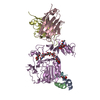
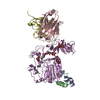
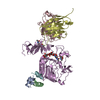
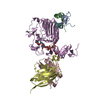
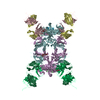

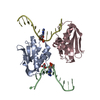
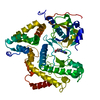
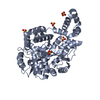
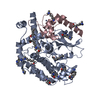
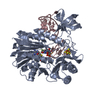

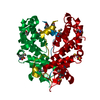
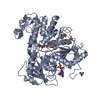

 PDBj
PDBj
















